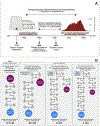The genetic legacy of African Americans from Catoctin Furnace
- PMID: 37535739
- PMCID: PMC10958645
- DOI: 10.1126/science.ade4995
The genetic legacy of African Americans from Catoctin Furnace
Abstract
Few African Americans have been able to trace family lineages back to ancestors who died before the 1870 United States Census, the first in which all Black people were listed by name. We analyzed 27 individuals from Maryland's Catoctin Furnace African American Cemetery (1774-1850), identifying 41,799 genetic relatives among consenting research participants in 23andMe, Inc.'s genetic database. One of the highest concentrations of close relatives is in Maryland, suggesting that descendants of the Catoctin individuals remain in the area. We find that many of the Catoctin individuals derived African ancestry from the Wolof or Kongo groups and European ancestry from Great Britain and Ireland. This study demonstrates the power of joint analysis of historical DNA and large datasets generated through direct-to-consumer ancestry testing.
Conflict of interest statement
Competing Interests:
É.H., S.Mi., W.F., K.B., E.J., H.L.G., S.A.E, J.M. and members of the 23andMe Research Team are employees of and have stock, stock options, or both, in 23andMe. The remaining authors declare no competing interests.
Figures








Comment in
-
The chloramine dilemma.Science. 2024 Nov 22;386(6724):851-852. doi: 10.1126/science.adt8921. Epub 2024 Nov 21. Science. 2024. PMID: 39571038
References
-
- Eltis D, Richardson D, Atlas of the Transatlantic Slave Trade (Yale University Press, 2010).
-
- U.S. Census Bureau QuickFacts: United States, (available at https://www.census.gov/quickfacts/fact/table/US/RHI225219#RHI225219).
-
- Williams HA, Help me to find my people: The African American search for family lost in slavery (Univ of North Carolina Press, 2012).
-
- Anderson EY, Catoctin Furnace: Portrait of an Iron Making Village (Arcadia Publishing, 2013).
-
- Catoctin Furnace Historical Society, Compiled by donated labor for the Catoctin Furnace Historical Society. Primary manager, Elizabeth Anderson Comer., Access database of confirmed and potential members of the Catoctin Furnace community. (2015).
MeSH terms
Grants and funding
LinkOut - more resources
Full Text Sources

